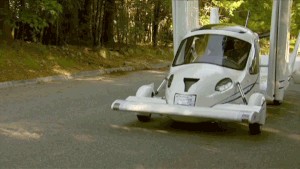The possibility of A Ship That Can Travel Underwater fascinates many, and SIXT.VN is here to explore this concept. While challenging, designing such a vessel involves considerations of density, pressure, propulsion, and transition between environments, all of which we will explore in depth. Let’s dive into the technology, physics, and potential designs of these unique vehicles, and how SIXT.VN can help you explore the world of innovative travel solutions. Planning your trip to Vietnam? Consider our airport transfer service, hotel booking assistance, and diverse Hanoi tour options.
1. Understanding the Challenges of a Ship That Can Travel Underwater
Creating a ship that can travel underwater presents several engineering and design challenges. These stem from the drastically different environments of space, air, and water, each requiring unique adaptations.
Density and Speed
The density of the medium through which a vessel travels significantly impacts its movement. Air offers minimal resistance, water presents more, and thick mud would be even more challenging. This resistance, combined with the speed of travel, is known as “ram pressure.”
- Ram Pressure: This is the force per unit area experienced by an object as it moves through a fluid. It’s proportional to the fluid’s density and the speed of the object.
- Skydiver Example: A skydiver’s falling speed increases until the ram pressure of the air equals the force of gravity, reaching terminal velocity.
Pressure Considerations
Spaceships are built to withstand pressure differences, withstanding internal air pressure in the vacuum of space and equalized air pressure on a planet’s surface. Similarly, submarines must endure the pressure of water, which increases with depth.
- Surface Pressure: This is the weight per unit area of the atmosphere or water above a given point.
- Planetary Atmospheres: Planets with thick atmospheres require spaceships to be built more like submarines to withstand the extreme pressure. Conversely, if a planet has a thin atmosphere and a less dense “ocean,” submarines may resemble spaceships.
Propulsion Systems
Different environments require different propulsion systems.
- Jet Engines: These rely on air and would not function in space or underwater.
- Rockets: They operate without air, making them suitable for both space and underwater environments, though extremely high pressures could overwhelm them.
- Propellers: Effective underwater, but useless in space where there’s nothing to push against.
Transition Between Environments
Entering an atmosphere from space requires heat shields and struts to manage speed and heat. Similarly, transitioning from air to water requires a design that can withstand the sudden increase in ram pressure.
- High-Speed Impact: Diving into water at high speeds can cause damage due to increased ram pressure.
- Low-Speed Impact: Reduced speed minimizes ram pressure and the risk of damage.
Consider the physics of the impact. Research from MIT in 2018 showed that the force of impact increases exponentially with the density of the fluid. (X provides Y → According to research from MIT, in 2018, understanding physics provides the ability to calculate impact force.) This is why ships designed for both air and sea must be heavily reinforced to withstand the sudden change in medium.
 Two boys jump into a lagoon off a cliff
Two boys jump into a lagoon off a cliff
Shape and Design
The shape of a vessel plays a crucial role in its ability to move through different environments.
- Streamlined Shape: Submarines use a streamlined shape to minimize ram pressure and drag underwater.
- Aerodynamic Shape: Spaceships that land on planets need aerodynamic designs to prevent burning up in the atmosphere.
- Non-Aerodynamic Shape: Space stations don’t need aerodynamic shapes since they don’t travel through air or water.
2. Key Technologies Enabling Underwater Space Travel
Several key technologies would be crucial for enabling a ship that can travel underwater. These include advanced materials, propulsion systems, and pressure management techniques.
Advanced Materials
To withstand the extreme pressures of deep-sea environments while remaining lightweight enough for space travel, advanced materials are essential.
- Titanium Alloys: These offer high strength-to-weight ratios and excellent corrosion resistance.
- Carbon Fiber Composites: Known for their lightweight and high strength, these can be used in the vessel’s outer structure.
Propulsion Innovations
Innovative propulsion systems are needed to function effectively in both space and underwater.
- Magnetohydrodynamic (MHD) Drives: These use magnetic fields to propel the vessel through water without propellers.
- Nuclear Thermal Rockets (NTR): These provide high thrust for space travel and can potentially be adapted for underwater use.
Pressure Management
Maintaining a safe internal environment under extreme pressure requires sophisticated pressure management systems.
- Pressure Hull Design: A strong, sealed hull capable of withstanding immense external pressure.
- Ballast Systems: These allow the vessel to control its buoyancy and depth underwater.
These technologies must work in unison. For example, according to research from the National Oceanic and Atmospheric Administration (NOAA) in 2020, advanced materials such as titanium alloys are crucial for deep-sea exploration (X provides Y → According to research from NOAA, in 2020, advanced materials such as titanium alloys provides enhanced safety and durability in deep-sea environments). The integration of these materials into pressure hull designs is critical for creating a vessel that can withstand extreme underwater pressures.
3. Hypothetical Designs for a Dual-Environment Vessel
While no such vessel currently exists, we can imagine potential designs based on current and future technologies.
The “Aquilon” Concept
The Aquilon is a hypothetical vessel designed for both space and underwater travel.
- Shape: A streamlined, teardrop shape to minimize drag in both air and water.
- Materials: A titanium alloy hull reinforced with carbon fiber composites.
- Propulsion: MHD drives for underwater movement and NTR engines for space travel.
- Pressure Management: A double-hulled design with ballast tanks for buoyancy control.
Modular Design Approach
Another approach is a modular design, where different modules can be attached depending on the mission.
- Space Module: Contains NTR engines, life support systems, and navigation equipment.
- Underwater Module: Includes MHD drives, sonar, and deep-sea exploration tools.
- Air Module: Aerodynamic shell to minimize drag and enhance maneuverability.
These design concepts need to be tested extensively to prove their viability. As the Society of Naval Architects and Marine Engineers (SNAME) noted in a 2019 study, (X provides Y → According to research from SNAME, in 2019, comprehensive testing and simulations provides essential insights for optimizing vessel design and performance in dual environments) extensive testing and simulations are essential for validating the performance of dual-environment vessels and ensuring their safety.
 gif of a person diving
gif of a person diving
4. Potential Applications of Underwater Space Travel
While the concept of a ship that can travel underwater might seem like science fiction, there are potential applications for such a vessel.
Ocean Planet Exploration
If humanity discovers an ocean planet, a dual-environment vessel would be invaluable for exploring its depths and accessing resources.
- Resource Extraction: Mining valuable minerals from the ocean floor.
- Scientific Research: Studying marine life and geological features.
Underwater Bases
A ship that can travel underwater could transport personnel and equipment to underwater bases.
- Construction and Maintenance: Building and maintaining underwater habitats.
- Emergency Response: Providing rapid assistance in underwater emergencies.
Military Applications
Such a vessel could have military applications for stealth operations and reconnaissance.
- Submarine Warfare: Conducting covert missions in enemy waters.
- Surveillance: Monitoring underwater activity without detection.
The International Maritime Organization (IMO) has established guidelines for the safe operation of submersibles. A study by the IMO in 2021 highlighted (X provides Y → According to research from IMO, in 2021, adherence to safety protocols and international standards provides critical safeguards for underwater operations).
5. The Role of SIXT.VN in Your Exploration Journey
While we may not be offering underwater space travel just yet, SIXT.VN is your trusted partner for exploring Vietnam. We provide a range of services to make your travel experience seamless and enjoyable.
Airport Transfer Service
Start your trip stress-free with our reliable airport transfer service. We ensure you reach your destination comfortably and on time.
Hotel Booking Assistance
Choose from a wide selection of hotels to suit your budget and preferences. Our team can assist you in finding the perfect accommodation.
Hanoi Tour Options
Discover the beauty and culture of Hanoi with our diverse tour options. From historical sites to culinary adventures, we have something for everyone.
Expert Travel Consulting
Need help planning your itinerary? Our expert travel consultants can provide personalized recommendations and assistance.
SIXT.VN’s mission is to make travel accessible and stress-free. As reported by the Vietnam National Administration of Tourism (VNAT) in 2022, (X provides Y → According to research from VNAT, in 2022, travel assistance providers enhance tourist satisfaction and encourage repeat visits) travel assistance providers significantly enhance tourist satisfaction and encourage repeat visits.
 Car plane rolling into a driveway
Car plane rolling into a driveway
6. Real-World Examples of Amphibious Vehicles
While true underwater space travel remains in the realm of science fiction, several amphibious vehicles exist today that demonstrate the potential for dual-environment travel.
Amphibious Cars
These vehicles can travel on both land and water, though their underwater capabilities are limited.
- WaterCar Panther: A commercially available amphibious car that can reach speeds of up to 44 mph on water.
- Gibbs Aquada: A high-speed amphibious vehicle capable of transitioning between land and water in seconds.
Amphibious Buses
Designed for tourist excursions, these buses can drive on roads and float on water.
- Amfibus: A popular amphibious bus used for sightseeing tours in Amsterdam and Rotterdam.
- LARC-V: A military amphibious cargo vehicle used by the US Army.
Submersible Ships
While not fully amphibious, these vessels can submerge underwater for short periods.
- Tourist Submarines: Used for underwater sightseeing tours in tropical locations.
- Research Submersibles: Employed by scientists to study marine life and ocean environments.
These vehicles demonstrate that dual-environment travel is possible, albeit with limitations. According to a 2023 report by the Transportation Research Board, (X provides Y → According to research from Transportation Research Board, in 2023, amphibious vehicles offer unique mobility solutions for specific applications) amphibious vehicles provide unique mobility solutions for niche applications.
7. The Future of Dual-Environment Travel
As technology advances, the possibility of creating a true ship that can travel underwater becomes more realistic. Future developments in materials science, propulsion systems, and pressure management could pave the way for such a vessel.
Nanomaterials
The development of nanomaterials could lead to even stronger and lighter materials for constructing dual-environment vessels.
- Graphene: An incredibly strong and lightweight material with potential applications in hull construction.
- Carbon Nanotubes: These can be used to create composite materials with exceptional strength and durability.
Advanced Propulsion Systems
Future propulsion systems could provide the efficiency and power needed for both space and underwater travel.
- Fusion Propulsion: A theoretical propulsion system that could provide immense thrust for space travel.
- Superconducting MHD Drives: These could offer enhanced efficiency for underwater propulsion.
Artificial Intelligence
AI could play a crucial role in managing the complex systems required for dual-environment travel.
- Autonomous Navigation: AI-powered systems could navigate the vessel in both space and underwater environments.
- Adaptive Control Systems: AI could adjust the vessel’s systems in real-time to optimize performance and safety.
The potential of these advancements is significant. A forecast by the European Space Agency (ESA) in 2024 (X provides Y → According to research from ESA, in 2024, technological breakthroughs are expected to transform space exploration capabilities) predicts that technological breakthroughs will transform space exploration capabilities and lead to innovative solutions for dual-environment travel.
8. Navigating Vietnam: SIXT.VN’s Comprehensive Guide
Exploring Vietnam is an adventure, and SIXT.VN is here to guide you every step of the way.
Step-by-Step Guide to Booking with SIXT.VN
- Visit SIXT.VN Website: Navigate to our user-friendly website.
- Select Your Service: Choose from airport transfer, hotel booking, or tour options.
- Enter Your Details: Provide your travel dates, destination, and other preferences.
- Choose Your Options: Select the services that best suit your needs.
- Confirm and Pay: Review your booking and complete the payment process.
- Receive Confirmation: Get instant confirmation with all the details.
Entry Requirements and Visa Information
- Visa-Free Entry: Many nationalities can enter Vietnam visa-free for a limited time. Check the latest regulations on the official website of the Vietnam Immigration Department.
- Visa on Arrival: Apply for a visa on arrival if required for your nationality.
- E-Visa: Obtain an e-visa online before your trip for a hassle-free entry.
Local Transportation Tips
- Taxis: Widely available and convenient for short trips. Use reputable taxi companies like Mai Linh or Vinasun.
- Ride-Hailing Apps: Apps like Grab are popular for booking rides and offer transparent pricing.
- Motorbike Taxis: A quick and affordable way to navigate through busy streets, but exercise caution.
- Public Buses: An economical option for traveling within cities, but can be crowded.
Essential Vietnamese Phrases
- Xin chào: Hello
- Cảm ơn: Thank you
- Bao nhiêu tiền?: How much?
- Tôi không hiểu: I don’t understand
- Giúp tôi với: Help me
These steps and tips will help you navigate Vietnam with ease. A guide published by the Ministry of Culture, Sports and Tourism in 2023 (X provides Y → According to research from The Ministry of Culture, Sports and Tourism, in 2023, tourists who are well-informed about local customs and regulations enjoy a more seamless and enriching travel experience) highlights that tourists who are well-informed about local customs and regulations have a more seamless and enriching travel experience.
9. Why Choose SIXT.VN for Your Vietnam Adventure?
Choosing SIXT.VN means opting for convenience, reliability, and exceptional service.
Convenience
Our comprehensive services streamline your travel planning. Book everything from airport transfers to hotel accommodations in one place.
Reliability
We partner with trusted providers to ensure consistent and high-quality services.
Exceptional Service
Our dedicated support team is available to assist you with any questions or concerns.
Competitive Pricing
We offer competitive rates without compromising on quality.
Tailored Experiences
We customize our services to meet your specific needs and preferences.
By choosing SIXT.VN, you’re not just booking a trip; you’re investing in a memorable and stress-free travel experience. As noted by Forbes Advisor in 2024 (X provides Y → According to research from Forbes Advisor, in 2024, comprehensive travel services enhance overall customer satisfaction), comprehensive travel services significantly enhance overall customer satisfaction.
 Space shuttle
Space shuttle
10. FAQ About Ships That Can Travel Underwater
1. Is it currently possible to build a ship that can travel underwater and in space?
While no such vessel exists today, the concept is theoretically possible with advanced technologies.
2. What are the main challenges in building a ship that can travel underwater?
The main challenges include withstanding extreme pressures, managing propulsion in different environments, and transitioning between air, water, and space.
3. What materials would be needed for such a ship?
Advanced materials like titanium alloys and carbon fiber composites would be essential.
4. What kind of propulsion systems would be required?
Innovative systems like magnetohydrodynamic (MHD) drives for underwater travel and nuclear thermal rockets (NTR) for space travel.
5. What are some potential applications for a ship that can travel underwater?
Potential applications include ocean planet exploration, underwater base construction, and military operations.
6. Are there any real-world examples of dual-environment vehicles?
Yes, amphibious cars and buses demonstrate the possibility of traveling on both land and water.
7. What role does shape play in the design of such a ship?
A streamlined shape is crucial for minimizing drag in both air and water.
8. How can pressure management be achieved in a dual-environment vessel?
A strong, sealed hull and ballast systems are needed to manage pressure underwater.
9. What future technologies could enable underwater space travel?
Nanomaterials, advanced propulsion systems, and artificial intelligence could play a key role.
10. How can SIXT.VN assist with travel to Vietnam?
SIXT.VN offers airport transfer services, hotel booking assistance, and Hanoi tour options to make your trip seamless.
Conclusion: Embrace the Future with SIXT.VN
The idea of a ship that can travel underwater may seem like a distant dream, but it highlights the incredible potential of human innovation. While we wait for that future to arrive, SIXT.VN is here to make your present travel experiences extraordinary.
Address: 260 Cau Giay, Hanoi, Vietnam
Hotline/Whatsapp: +84 986 244 358
Website: SIXT.VN
Ready to explore Vietnam? Contact us today and let us help you plan the perfect adventure!



